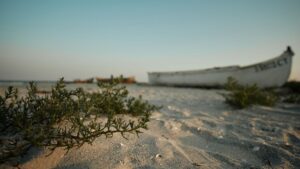 Once a vast expanse of shimmering blue the Aral Sea was the pride of Central Asia. Straddling Kazakhstan to the north and Uzbekistan to the south, it was the world’s fourth-largest inland water body. It was a lifeline for the region, teeming with fish, bustling ports, and vibrant communities thriving along its shores.
Once a vast expanse of shimmering blue the Aral Sea was the pride of Central Asia. Straddling Kazakhstan to the north and Uzbekistan to the south, it was the world’s fourth-largest inland water body. It was a lifeline for the region, teeming with fish, bustling ports, and vibrant communities thriving along its shores.
But the mid-20th century marked the beginning of its decline. As part of Soviet-era irrigation projects, the waters of the Syr Darya and Amu Darya rivers once the Aral’s lifeblood were diverted to grow cotton and other crops. The Aral began to shrink rapidly, leaving behind parched landscapes and ghostly shipwrecks marooned in desert sands. By the early 21st century, it was a shadow of its former self, its once-abundant ecosystem shattered and its communities struggling to survive.
Scientists and environmentalists sounded alarms. The drying of the Aral Sea was not just a local tragedy; it symbolized the consequences of unchecked human interference with nature. The region faced harsher climates, toxic dust storms, and dwindling livelihoods.
Yet, the story didn’t end there. Efforts to revive the northern part of the sea began with the construction of the Kok-Aral Dam in Kazakhstan. Slowly, water levels rose, fish returned, and hope was rekindled. Though much of the southern sea remains lost, the partial recovery of the northern Aral serves as a reminder of nature’s resilience and humanity’s capacity to make amends.
History of Change and Resilience
The story of the Aral Sea nestled in Central Asia once-mighty saltwater lake bears a rich history shaped by climate shifts, geological forces, and human ambition. Centuries ago, the rivers Amu Darya and Syr Darya carried life-giving waters into the Aral, nurturing a thriving ecosystem. But this wasn’t always a steady rhythm. Climate shifts caused the sea to rise and fall, with cold, dry periods slowing glacial melts and reducing river inflow. Sometimes, the Amu Darya changed its course entirely, redirecting water to other basins like the Sarykamysh, leaving the Aral vulnerable.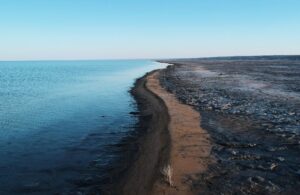
Humans, too, played their part. Ancient irrigation systems drew water from these rivers to cultivate crops in the dry Central Asian plains. The practice, though vital for agriculture, began to chip away at the sea’s water supply. Even so, the Aral endured, adapting to these natural and man-made fluctuations.
By the Tang dynasty, the Aral Sea marked the western frontier of the Chinese Empire, a silent witness to the movement of goods and cultures along the Silk Road. Fast forward to the mid-19th century, and the sea found itself in the sights of Russian explorers. In 1848, Alexey Butakov led an expedition to map and study the lake, providing the first scientific observations of this vast inland water body.
Just three years later, the first steamer arrived on the Aral, symbolizing a new era of human interaction. It wasn’t long before fishing emerged as a booming industry. Visionaries like Lapshin, Ritkin, Krasilnikov, and Makeev turned the region into a hub of activity, forming fishing unions that flourished for decades.
But the Aral’s history isn’t just about its glory days. It is also a tale of exploitation and resilience. For centuries, the rivers that fed it were tapped for agriculture, but it was during the Soviet era that the scale of irrigation projects skyrocketed. The once-mighty inflows dwindled, and the Aral began its dramatic retreat. Yet, even in decline, its story drew scientists, explorers, and policymakers, all striving to understand and perhaps reverse its fate.
Artifacts like Taras Shevchenko’s 1848 watercolor of the first Russian boats on the Aral and the detailed maps from that era remind us of a time when the sea was a beacon of promise. Today, they stand as poignant reminders of a history shaped by the delicate balance between nature and human ambition. The Aral Sea’s story is not just about water it’s about people, ecosystems, and the enduring impact of our choices.
Diminishing Aral Sea: A Tale of Transformation
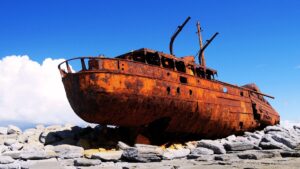 In 1960, the Aral Sea was a sprawling expanse of saltwater, its surface sitting 175 feet above sea level and stretching over 26,300 square miles. As the rivers dried up in the summer months, the Aral Sea began to shrink rapidly. By 1980s, evaporation claimed its waters faster than they could be replenished. What was once the world’s fourth-largest inland sea began to retreat, leaving behind barren salt plains and stranded fishing boats in the sand.
In 1960, the Aral Sea was a sprawling expanse of saltwater, its surface sitting 175 feet above sea level and stretching over 26,300 square miles. As the rivers dried up in the summer months, the Aral Sea began to shrink rapidly. By 1980s, evaporation claimed its waters faster than they could be replenished. What was once the world’s fourth-largest inland sea began to retreat, leaving behind barren salt plains and stranded fishing boats in the sand.
By 1989 the sea had split into two distinct parts: the “Greater Sea” in the south and the “Lesser Sea” in the north. Its salinity tripled, devastating the marine ecosystem and ending the livelihoods of fishing communities. Governments in the region tried to curb water usage and save the Aral, but coordination between competing states proved difficult.
By the 1990s, the sea’s area had halved, and its water level had dropped by 50 feet. The once-thriving lake was a shadow of its former self, split further into three separate lakes by the century’s end. The eastern portion suffered the most, diminishing by four-fifths between 2006 and 2009 and, at times, drying up entirely.
Yet, not all hope was lost. In 2005, with funding from the World Bank, Kazakhstan constructed the Kok-Aral Dam, which helped stabilize the northern portion of the sea. Fish began to return, and the water level rose slightly, offering a glimmer of hope for the Lesser Sea. However, the southern portion continued to shrink, with the eastern lobe becoming a dry bed of salt and sand.
Destruction of the Aral Sea: A Tale of Environmental climate change, Economic and Public Health Collapse
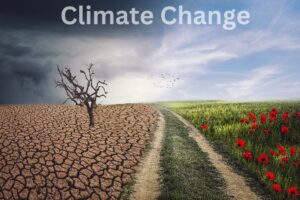 Once the Aral Sea was a lifeline. Its waters nourished a rich ecosystem, supported thriving communities, and sustained industries. What was once one of the world’s largest inland bodies of water is now an example of ecosystem collapse, its story a stark warning for future generations.
Once the Aral Sea was a lifeline. Its waters nourished a rich ecosystem, supported thriving communities, and sustained industries. What was once one of the world’s largest inland bodies of water is now an example of ecosystem collapse, its story a stark warning for future generations.
The decline of the Aral Sea didn’t happen overnight. The ecosystems that once flourished around the Aral Sea and in the river deltas feeding it were nearly destroyed. The water, which had once been teeming with life, became inhospitable. Its salinity levels skyrocketed, making it nearly ten times saltier than ocean water. The harsh conditions of the Aral Sea’s remaining waters and the surrounding environment have caused widespread devastation. The drying of the sea left behind vast plains covered with salt, pesticide runoff, and industrial waste. For decades, these pollutants had leached into the water from agricultural and industrial activities, turning the area into a toxic wasteland.
The consequences of this environmental collapse were felt far beyond the sea itself. The toxic dust that now blankets the region is a constant threat. The dry seabed, once submerged in water, is now a source of windborne pollution, carrying harmful chemicals like HCH, TCCD, DDT, and heavy metals through the air. These pollutants, absorbed by plants and livestock, entered the food chain, poisoning everything in their path. The local population, many of whom relied on the land for their livelihoods, were left with no choice but to drink polluted water, breathe in toxic dust, and consume contaminated crops and meat.
As the pollution spread, so did the health problems. Respiratory illnesses, including drug-resistant tuberculosis, became common in the region. Digestive disorders, anemia, liver and kidney diseases, and eye problems were widespread. The inhabitants of these once-thriving areas found themselves living in a poisoned environment, where survival became an uphill battle. Child mortality rates soared by 2009, 75 children out of every 1,000 born in the region did not survive their early years. Maternal mortality was also alarmingly high, with 12 deaths for every 1,000 births. The combination of pollution, poor healthcare, and lack of clean water took an unbearable toll on the population.
The environmental degradation also took a severe toll on agriculture, which had once been the economic lifeblood of the region. As the wind carried salt and toxic chemicals across the land, crops began to fail. The soil, once rich and fertile, became inhospitable. Farmers in Kazakhstan, who had once grown a wide variety of crops, found that only a few hardy varieties could survive in the new, salty earth. Some fields had to be flushed with water up to four times a day to remove the toxic salt and chemicals, but this was hardly enough to restore the soil to its former state. By the end of the 1990s, a study showed that only fodder crops, used primarily for livestock, could tolerate the harsh conditions. Other crops, such as wheat and cotton, could no longer be grown in the area.
In addition to the loss of agricultural productivity, the broader climate of the region was dramatically altered. Inland seas and lakes like the Aral Sea play a crucial role in regulating the local climate. They moderate temperatures, humidify the air, and reduce the severity of seasonal extremes. With the disappearance of the Aral Sea, however, these stabilizing effects were lost. The region now experiences more extreme temperature variations—annual temperature fluctuations have increased by as much as 4 to 12 degrees Celsius. Summers are hotter, and winters are colder. The lack of moisture in the air has also led to more frequent and severe dust storms, further complicating the lives of the local population. These dust storms carry salt and toxins, further degrading the environment and damaging the crops that manage to survive.
Economically, the collapse of the Aral Sea devastated the livelihoods of many people. Once a thriving fishing industry had to shut down as fish populations vanished along with the water. Communities that depended on the sea for sustenance were left without work and without a future. The decline of agriculture and the loss of traditional livelihoods forced many people to leave their homes in search of better opportunities elsewhere. The economic collapse was not just about the loss of industry; it was about the loss of a way of life that had sustained generations of families.
In the face of this environmental disaster, efforts to mitigate the damage have been slow and difficult. Regional governments have tried to reduce the amount of water diverted for irrigation, but the damage was already done. In 2005, Kazakhstan constructed the Kok-Aral Dam, which successfully restored some water to the northern part of the Aral Sea, improving the water levels and allowing for limited recovery. However, much of the southern part of the sea remains dry, with no immediate solutions in sight. The recovery efforts have been hindered by the political complexities of coordinating action between the Central Asian states, each with its own priorities and interests.
The Silent Suffering: Women and Children in the Aral Sea Crisis
The vulnerable populations bear the brunt of the crisis, their lives irrevocably altered by polluted water, toxic dust, and an absence of adequate healthcare infrastructure. The plight of these individuals underscores the profound human cost of ecological mismanagement.
Women and children living near the Aral Sea face an invisible enemy: toxins embedded in their environment. The dried seabed, once submerged under the Aral’s vast waters, now releases clouds of dust laced with harmful chemicals, including organochlorides, PCBs, DDT compounds, and TCDD. These chemicals, byproducts of pesticide use and industrial activities, infiltrate the lives of those who live near the sea.
For women, the crisis begins to take a toll even before birth. Many of these toxins have been detected in the blood and breast milk of mothers, passing silently from one generation to the next. This transmission of pollutants to unborn and newborn children leads to devastating health consequences. Babies are frequently born with low birth weights and congenital abnormalities at rates significantly higher than in other regions. In fact, the rate of infants born with abnormalities in the Aral Sea region is five times higher than in European countries.
The statistics are alarming: 26% of children in this region are born at low birth weight, a figure that deviates significantly from global norms as documented by the World Health Organization (WHO). These underweight births set the stage for a lifetime of health challenges, exacerbated by a polluted environment and inadequate medical care.
Childhood Health Under Siege
For children, the dangers of the Aral Sea crisis extend beyond birth. Exposure to the toxic chemicals carried by wind and water leads to severe health issues, many of which are poorly understood due to limited research. Among these, renal tubular dysfunction has emerged as a pressing concern. This condition, which disrupts the kidneys’ ability to process waste, is alarmingly prevalent in the region. It is often accompanied by growth and developmental stunting, compounding the already dire circumstances for young lives.
The health crisis is deepened by the lack of resources to study, understand, and mitigate these issues. Between 1994 and 2008, only 26 peer-reviewed articles and four reports addressed children’s health in the Aral Sea region. This glaring gap in research leaves families and health professionals without the tools to address the root causes of these ailments. Meanwhile, the conditions persist, taking a devastating toll on the region’s youngest and most vulnerable inhabitants.
A Crippled Healthcare System
 The Aral Sea crisis has laid bare the fragility of healthcare systems in affected areas, particularly in Kazakhstan and Uzbekistan. Medical facilities are often ill-equipped to handle the surge of health issues resulting from the ecological collapse. Many clinics lack basic medications and equipment, forcing healthcare workers to operate under extreme limitations. Even the most basic health interventions, such as treating malnourished children or addressing respiratory illnesses caused by toxic dust, are hampered by a shortage of resources.
The Aral Sea crisis has laid bare the fragility of healthcare systems in affected areas, particularly in Kazakhstan and Uzbekistan. Medical facilities are often ill-equipped to handle the surge of health issues resulting from the ecological collapse. Many clinics lack basic medications and equipment, forcing healthcare workers to operate under extreme limitations. Even the most basic health interventions, such as treating malnourished children or addressing respiratory illnesses caused by toxic dust, are hampered by a shortage of resources.
Poverty Amplifies Vulnerability
The impoverished communities of the Aral Sea region have been the first and hardest hit by the crisis. Representing over 4.4 million people, these populations live downstream from the basin or in former coastal areas. For many, the loss of the sea meant the loss of livelihoods, as fishing and agriculture collapsed alongside the ecosystem. Already struggling to meet basic needs, these families now contend with health crises that they are ill-equipped to manage.
Extreme climate change through drying of the Aral Sea
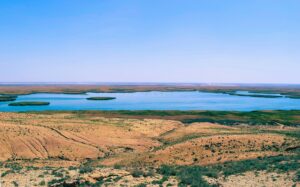 In the 1960s, the Aral Sea was the world’s fourth-largest lake, its waters teeming with sturgeon, carp, barbel, and roach. But by the late 1980s, over half its volume had vanished, leaving behind a hyper-saline body of water inhospitable to life. The rise in salinity wiped out the once-abundant fish populations, silencing an industry that had sustained thousands. Fishing ports like Aral in the northeast and Mŭynoq in the south, once bustling hubs of economic activity, now sit far from the water’s edge ghost towns on an arid plain.
In the 1960s, the Aral Sea was the world’s fourth-largest lake, its waters teeming with sturgeon, carp, barbel, and roach. But by the late 1980s, over half its volume had vanished, leaving behind a hyper-saline body of water inhospitable to life. The rise in salinity wiped out the once-abundant fish populations, silencing an industry that had sustained thousands. Fishing ports like Aral in the northeast and Mŭynoq in the south, once bustling hubs of economic activity, now sit far from the water’s edge ghost towns on an arid plain.
The collapse of the fishing industry alone forced families to abandon centuries-old trades, pushing many into poverty and migration. The sea’s disappearance has also altered the region’s climate. Acting as a natural thermal regulator, the Aral Sea once moderated the harsh winters and scorching summers of Central Asia. Without its waters, the annual temperature range has widened dramatically, bringing more extreme weather conditions. Summers have grown hotter, and winters colder, complicating agriculture and day-to-day life for those living in the area.
The exposed seabed, stripped of its water cover, has become a source of relentless dust storms. These storms spread salt and chemical residues over vast distances, creating a localized microclimate of devastation. The salt-laden winds damage crops, erode soil fertility, and make farming nearly impossible in the affected areas, further deepening the ecological and economic crisis.
During the Cold War, the island was used for experiments with agents such as tularemia, bubonic plague, and anthrax. Hundreds of tons of live anthrax bacteria were buried there in the 1980s. In 1999, traces of these dangerous spores were uncovered, posing a grave risk to nearby communities. A cleanup operation led by the United States in 2002 mitigated some of the immediate dangers, but concerns about long-term contamination remain.
The Plague of Toxic Dust
The receding waters revealed a seabed soaked in decades of agricultural runoff salt, fertilizers, and pesticides that had accumulated over time. When the wind sweeps across this toxic plain, it lifts fine particles into the atmosphere, creating plumes of poisonous dust that spread across the region. The hardest-hit are the Karakalpaks, a community living in the southern reaches of the former sea.
This airborne menace has brought a public health crisis of staggering proportions. High rates of throat cancer, anemia, kidney disease, and respiratory problems have been reported among the local population. Infant mortality, one of the most tragic indicators of health, ranks among the highest in the world in this region.
A Warning for the Future
The story of the Aral Sea is not just a regional disaster; it is a warning for the global community. The mismanagement of water resources for agricultural purposes primarily to grow water-intensive cotton in an arid region set the stage for this catastrophe. The ecological collapse of the Aral Sea underscores the importance of balancing human development with environmental sustainability.
Efforts to mitigate the damage have seen limited success. The construction of the Kokaral Dam in Kazakhstan has stabilized water levels in the northern part of the sea, bringing some hope of revival to a fraction of the ecosystem. However, the southern Aral Sea, shared with Uzbekistan, continues to shrink, and the vast majority of the damage appears irreversible.
The story of the Aral Sea is a heartbreaking example of what happens when humans push nature too far. It’s a warning about what can go wrong when we mismanage the environment, ignore the effects of climate change, and focus too much on industrial growth without thinking about the consequences.
What happened to the Aral Sea isn’t just about losing a body of water it’s about millions of people whose lives have been turned upside down. Families lost their livelihoods, their health suffered, and entire communities were left struggling. It’s a stark reminder that nature isn’t something we can take for granted.
When we ignore the balance of the environment, the price we pay isn’t just the loss of beautiful landscapes or wildlife it’s about real human survival. The collapse of the Aral Sea is a lesson for all of us to respect the limits of nature and make smarter, more thoughtful choices about how we use our planet’s resources.
